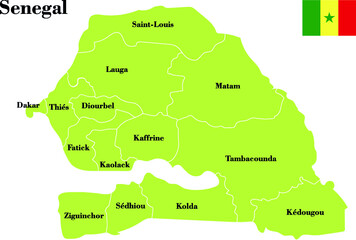Guide to Senegal

Background on Senegal
Senegal, officially the Republic of Senegal, is a country in West Africa, on the Atlantic Ocean coastline. Senegal is bordered by Mauritania to the north, Mali to the east, Guinea to the southeast and Guinea-Bissau to the southwest. Senegal nearly surrounds the Gambia, a country occupying a narrow sliver of land along the banks of the Gambia River, which separates Senegal's southern region of Casamance from the rest of the country. Senegal also shares a maritime border with Cape Verde. Senegal's economic and political capital is Dakar.
Senegal is notably the westernmost country in the mainland of the Old World, or Afro-Eurasia. It owes its name to the Senegal River, which borders it to the east and north. The climate is typically Sahelian, though there is a rainy season. Senegal covers a land area of almost 197,000 square kilometres (76,000 sq mi) and has a population of around 17 million. The state is a unitary presidential republic; since the country's foundation in 1960, it has been recognized as one of the most stable countries on the African continent.
The state was formed as part of the independence of French West Africa from French colonial rule. Because of this history, French is the official language, but it is understood only by a minority of the population. Over 30 languages are spoken in Senegal, and Wolof is the most widely spoken one, with 80% of the population speaking it as a first or second language, acting as Senegal's lingua franca alongside French. Like other post-colonial African states, the country includes a wide mix of ethnic and linguistic communities, with the largest being the Wolof, Fula, and Serer people. Senegalese people are predominantly Muslim.
Senegal is classified as a heavily indebted poor country, with a relatively low HDI ranked 170th in the Human Development Index. Most of the population is on the coast and works in agriculture or other food industries; other major industries include mining, tourism, and services. The country does not have notable natural resources, but the basis of its development lies in education, where almost half the state's budget is spent. Senegal is a member state of the African Union, the United Nations, the Economic Community of West African States (ECOWAS), Organisation internationale de la Francophonie, the Organization of Islamic Cooperation, and the Community of Sahel-Saharan States. Internationally, Senegal is best known in the sporting world for the Paris-Dakar Rally.
Source: Senegal-wikipedia
Agriculture
Agriculture is one of the dominant parts of Senegal's economy, despite the fact that Senegal lies within the drought-prone Sahel region. As only about 5% of the land is irrigated, Senegal continues to rely on rain-fed agriculture. Agriculture occupies about 75% of the workforce. Despite a relatively wide variety of agricultural production, the majority of farmers produce for subsistence needs. Millet, rice, corn, and sorghum are the primary food crops grown in Senegal. Production is subject to drought and threats of pests such as locusts, birds, fruit flies, and white flies. Moreover, the effects of climate change in Senegal are expected to severely harm the agricultural economy due to extreme weather such as drought, as well as increased temperatures.
Senegal is a net food importer, particularly of rice, which represents almost 75% of cereal imports. Peanuts, sugarcane, and cotton are important cash crops, and a wide variety of fruits and vegetables are grown for local and export markets. In 2006 gum Arabic exports soared to $280 million, making it by far the leading agricultural export. Green beans, industrial tomatoes, cherry tomatoes, melon, and mango are Senegal's main vegetable cash crops. The Casamance region, isolated from the rest of Senegal by the Gambia, is an important agriculture-producing area, but without the infrastructure or transportation links to improve its capacity.
Despite the lack of modernization of artisanal fishing, the fishing sector remains Senegal's main economic resource and major foreign exchange earner. The livestock and poultry sectors are relatively underdeveloped and have the potential for modernization, development and growth. Senegal imports most of its milk and dairy products. The sector is inhibited due to low output and limited investments. The potential production of fauna and forest products is high and diversified and could, if well organized, benefit poor farmers in rural areas. Although the agricultural sector was impacted by a locust invasion in 2004, it has recovered and gross agricultural production is expected to increase by 6.1% in 2006 and 5.1% in 2007.
Source: https://en.wikipedia.org/wiki/Senegal
Currency
The local currency used in Senegal is the West African CFA franc (code: XOF. Click here to view the exchange from USD TO XOF.
Health
To receive accurate and up-to-date information on general health information for travellers to Senegal, please click here.
Please make sure to check if a Covid vaccination and yellow fever vaccination cards will be required for your travel to Senegal.
Climate
Senegal’s climate could generally be described as tropical. However, the weather does vary in different parts of the country, broadly falling into three main zones:
The coastal region: the Atlantic coastal strip is cooler than inland, partly due to brisk onshore winds. Winter temperatures range from 18-26°C in January. In summer; maximum temperatures average around 31°C. Rains arrive in July, peak in August and tail off by October, bringing around 550mm of rainfall annually.
The Sahel region: the northern half of the country falls within the ‘Sahel belt’, a region of semi-arid land which spans across the African continent. Here, temperatures can be cool at night (dropping to around 14°C), but often reach 40°C by day. Rainfall is below 400mm.
The Southern region: the southern half of the country is hot and humid, with average maximum temperatures above 30°C throughout the year. Rainfall is usually over 1,500mm to the far south.
Source: https://www.senegel.org/en/senegal/climate



